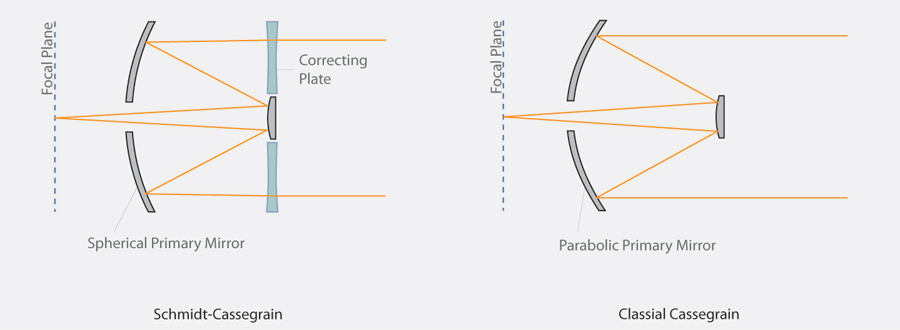A Few Important Numbers:
| Clear Aperture Diameter | 10.0 inches | 0.254m |
|---|---|---|
| Secondary Mirror Diameter | 3.7 inches | 0.094m |
| Effective Collecting Area | 271 inches 2 | 0.175m 2 |
| Diffraction Limit | 0.62 arcseconds | |
| Rough eyepiece to CCD focus correction | 1.25 turns CCW |
For full specifications see the user guide in Literature
The Schmidt-Cassegrain Design:
The Meade LX200 is a Schmidt-Cassegrain reflector telescope, a design popularised by amateur astronomy because of it's low aberrations at relatively low cost. The Schmidt-Cassegrain is extremely similar in design to the classical Cassegrain but features a couple of important differences. Firstly, the primary mirror is spherical as opposed to parabolic. It is this feature that makes them cheaper to produce as good quality parabolic mirrors are much harder to construct. However, Spherical mirrors do not focus to a point and it is this feature that introduces the need for the second difference from a classical Cassegrain, a correcting plate of glass.
The differences in design are illustrated below:
 |
| Figure 1: A comparison of the Schmidt-Cassegrain and the classical Cassegrain telescope designs. The spherical mirror and correcting plate is shown in the left schematic. |
Also of note is that although the aperture of the telescope is strictly 10", its mirror is oversized so that off axis rays near the edge of the field of view are also collected.
Mount and Tracking Tips
The telescope is mounted within the dome on a metal pillar in the Altitude-Azimuth setup, although it is good practice to ascertain that the telescope is not leaning by checking the spirit level bubble on the LX200's base. The mounting fork of the telescope can be either moved by hand (altitude movement is unlocked by unscrewing the knob at the top of the mounting arm and azimuth by releasing the catch on the base) or by the motor controlled with the remote.
The N,S,E & W buttons on the remote control the movement of the telescope in the altitude or azimuth and the slew speed can be set by first pressing 7 (slew) followed by one of the numbers 7,4,1 or 0 such that the adjacent LED flashes to indicate the selected slew speed.
With the longitude-latitude location of the telescope input along with the local time and after a brief alignment procedure, the motorised mount is capable of tracking the sky throughout the night. Past experience suggests that it is relatively easy to obtain tracking sufficient for an exposure of just over 10 seconds.
The LX200 also features two types of alignment procedure that are named '1 star' and '2 star alignment'. The first is technically sufficient if the telescope base is level and the time and date are properly input. It then only requires the user to slew the telescope to an object in the alignment stars catalogue so that it is centred in the field of view.
The second alignment method, 'star alignment' requires precise centring of two alignment stars, one after another. This should then compensate for a slightly unlevel base.
'Star alignment' may be necessary. It certainly was found to help slightly in the 2010-11 project.